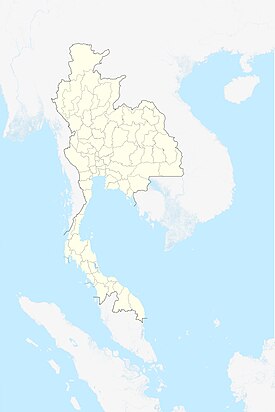
Back تايلاند في الحرب العالمية الثانية Arabic Tailandia na Segunda Guerra Mundial AST Тайланд във Втората световна война Bulgarian Tailandia en la Segunda Guerra Mundial Spanish Histoire de la Thaïlande pendant la Seconde Guerre mondiale French תאילנד במלחמת העולם השנייה HE Thailand dalam Perang Dunia II ID Thailandia nella seconda guerra mondiale Italian Tailândia na Segunda Guerra Mundial Portuguese Таиланд во Второй мировой войне Russian

Thailand officially adopted a neutral position during World War II until the five hour-long Japanese invasion of Thailand on 8 December 1941, which led to an armistice and military alliance treaty between Thailand and the Empire of Japan in mid-December 1941. At the start of the Pacific War, the Japanese Empire pressured the Thai government to allow the passage of Japanese troops to invade British-held Malaya and Burma. After the invasion, Thailand capitulated. The Thai government under Plaek Phibunsongkhram considered it profitable to co-operate with the Japanese war efforts, since Thailand saw Japan – who promised to help Thailand regain some of the Indochinese territories (in today's Laos, Cambodia, and Vietnam) which had been lost to France – as an ally against Western imperialism. Following added pressure from the start of the Allied bombings of Bangkok due to the alliance with Japan, Thailand declared war on the United Kingdom and the United States and annexed territories in neighbouring countries, expanding to the north, south, and east, gaining a border with China near Kengtung.[1]
After becoming an ally of the Empire of Japan, Thailand retained control of its armed forces and internal affairs. The Japanese policy on Thailand differed from their relationship with the puppet state of Manchukuo. Japan intended bilateral relationships similar to those between Nazi Germany and Finland, Bulgaria and Romania.[2] However, Thailand at that time was labelled by both the Japanese and the Allies as the "Italy of Asia" or "Oriental Italy", a secondary power.[3][4]
Meanwhile, the Thai government had split into two factions: the Phibun regime and the Free Thai Movement, a well-organised, pro-Allied resistance movement that eventually numbered around 90,000 Thai guerrillas,[5] supported by government officials allied to the regent Pridi Banomyong. The movement was active from 1942, resisting the Phibun regime and the Japanese.[6] The partisans provided espionage services to the Allies, performed some sabotage activities, and helped engineer Phibun's downfall in 1944. After the war, Thailand returned the annexed territories but received little punishment for its wartime role under Phibun.
Thailand suffered around 5,569 military deaths during the war, almost entirely due to disease.[clarification needed] Deaths in combat included 150 in the Shan States, 180 on 8 December 1941 (the day of both the brief Japanese invasion and the failed British assault on the Ledge), and 100 during the brief Franco-Thai War.[7][8]
- ^ Ronald Bruce St. John, The Land Boundaries of Indochina: Cambodia, Laos and Vietnam, p. 20.
- ^ E. Bruce Reynolds (1994). Thailand and Japan's Southern Advance 1940–1945. St. Martin's Press. ISBN 0-312-10402-2.
- ^ James F. Dunnigan. The World War II Bookshelf: Fifty Must-Read Books. Kensington Pub Corp, 2005. ISBN 0-8065-2649-1, p. 16.
- ^ Cite error: The named reference
Reynolds-2005was invoked but never defined (see the help page). - ^ Tim Lambert. A Short History of Thailand.
- ^ Bergin, Bob (December 2011). "OSS and Free Thai Operations in World War II" (PDF). Studies in Intelligence. 55 (4 (Extracts, December 2011)). Central Intelligence Agency. Archived from the original (PDF) on 10 September 2015. Retrieved 2 September 2021.
- ^ Eiji Murashima, "The Commemorative Character of Thai Historiography: The 1942–43 Thai Military Campaign in the Shan States Depicted as a Story of National Salvation and the Restoration of Thai Independence" Modern Asian Studies, vol. 40, no. 4 (2006), pp. 1053–96, p. 1057n.
- ^ Sorasanya Phaengspha (2002). The Indochina War: Thailand Fights France. Sarakadee Press.